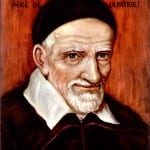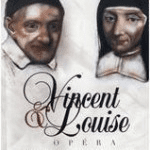
| On this page: | Paintings | Sculpture | Music |
Paintings
DePaul University Store – Artwork: Vincent
DePaul University Store – Artwork: Louise
DePaul University Image Archives – St. Louise
Woman Tree Art – Web Site of Sr. Maria Liebeck, D.C.
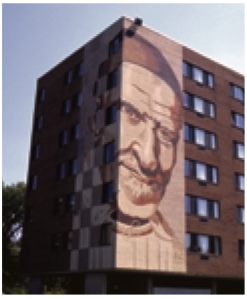
"We Are DePaul 2," A mural by Mark Elder, C.M. and students of DePaul University; mineral silicate paint on brick, Completed 2001.
The Making of an Icon from Nick Vassil on Vimeo.
Sculpture
Web site of Sr. Margaret Beaudette, S.C.
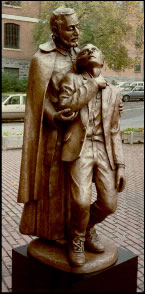
"St. Vincent DePaul and Sick Man" St. Vincent's Hospital New York, NY 5'3" Bronze, 1989
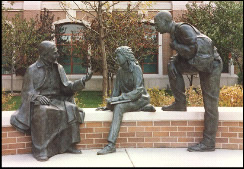
"The Way of Wisdom: St. Vincent DePaul and Students" DePaul University, Chicago, IL Life-Size Bronze, 1995
Web Site of Sr. Kathleen Aucoin, S.C.
Music
Nouveau chant à saint Vincent (New hymn to St. Vincent)
Le Frère Jacques Rovillain, Auxiliaire du Clergé, nous donne un nouveau chant à saint Vincent pour célébrer cet anniversaire. Paroles: Anonyme, Musique: Jacques Rovillain
Paroles et musique (Click here for words and music)
Festival of Religious Song in Kraków
On Vincent and Music
shared by Joe Gagliano
Vincent de Paul was a man noted for his many and varied talents and accomplishments, BUT nothing in his biographies suggest that included among them was a great passion for or involvement with the arts.
Yet, we do know that Vincent was man who believed in using all the tangible and intangible tools of his day to transform his world for the benefit of the poor, the sick, the dying, the homeless, and the marginalized.
So I ask: would Vincent use music as a tool for transformation?
If you have studied the life of Vincent you know that there is some scholarly debate about whether he was actually captured by pirates and sold into slavery. He tells of such events in one of his letters, but some scholars question whether those events really occurred or whether there were merely hyperbole – yet another example of Vincent using the one of the ordinary tools at his disposal – his writing – to transform. When describing part of his alleged period of involuntary servitude, Vincent tells a story of how he won his freedom by transforming the soul of the wife of one of the overlords of his captor. The overload had once been a Christian, but had abandoned the faith. As a result, his wife (believed to have been a Muslim) was always curious about Christianity. Vincent wrote that this woman would visit him in the fields where he toiled with the other Christian slaves. She would ask him to tell her about his faith. She always listed with the greatest of interest. One day, when the wife came to Vincent in the fields, Vincent looked around and thought of the Israelites’ captivity in Babylon. He intoned the psalm, “By the waters of Babylon,” followed by the Salve Regina and other songs of praise. The woman immediately went home to her husband and convinced him to assist in procuring Vincent’s release and safe passage back to Paris.



